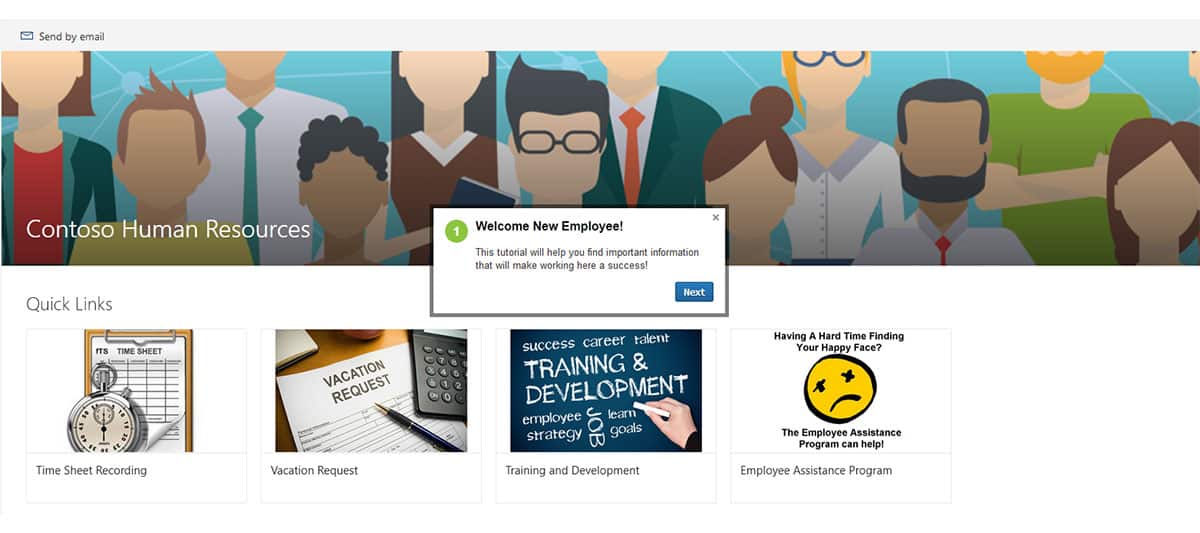
As part of this program, you broadcast daily links to help items by email to users.
It is not enough to show end users where to find help; you have to bring those help items into their inbox. This initiative should definitely be part of the Optimal Training Strategy.
To help employees learn over time how to create lists, use libraries, work with sites, make documents searchable, stick to governance policies, ensure regulatory compliance, etc. … broadcast help items by email one at a time over a period of time, regularly, and if needed, repeatedly.
Deploying daily tips campaigns is a way to enable continual micro-training and to set the stage for training programs No.4 and No.5: holding Q&A sessions, and providing context-sensitive help.
Besides making part of the overall Optimal Training Strategy, broadcasting help items is highly effective not only in improving the awareness of the applicable SharePoint capabilities but also in increasing usage overtime. As usage widens and deepens, data security, collaboration, productivity, and other intended outcomes materialize.
The point of enabling continual learning is to help your colleagues use SharePoint a little more than they do now, gradually. In the pursuit of mastery, regular learning is essential.
Some ways to broadcast help items are better than others. Many campaigns do fail to produce decent results.
When random tips are bulk sent at random intervals; recipients are more likely to simply ignore them. Just as they do for any other email, people won't act on an email content just because they receive it; some kind of a push is needed.
To be more effective with this method as the third program in your Optimal Training Strategy, aim to get end users to interact with every single help item that they receive.
Because your time is too valuable for déjà vu. VisualSP provides in-the-moment guidance for your team, so they can find answers without asking you (again).
Get started freeBroadcasting help items daily works better for the same reasons micro-training does. Bite-sized sets of information are easy to consume and easier to remember.
Send the link to the help item by email, the most familiar digital communication tool. The help item can be hosted on the SharePoint help site that you have started building in program No. 2 or on other external portals.
Consider the pointers below to ensure that every tip that you send actually contributes to the mastery of the platform in your organization.
To ensure that more people get involved, appoint a team of senders. Having the emails come from one executive works; but not as well as having them come from multiple executives and multiple informal leaders.
Appointing a team of senders helps you attract more people to the campaign, spread awareness, and initiate conversations about SharePoint. For example, if the campaign is set to last 90 days, appoint 30 most influential people and have them send out 3 emails each.
This approach works best because people tend to support what they help create.
Compel everyone to put the steps described in the help item into action the same day. Learning-by-doing is the best way to maximize information retention. Attach a fun challenge as a call-to-practice to every help item that you broadcast. This ensures that the help item is actually consumed, understood, and put into practice.
Avoid naming the call-to-practice "exercise" or "test"; use more fun words such as "challenge" or "contest".
When enough people take action, the campaign quickly gets traction and appears more important to everyone.
Make the consumption of the broadcasting help items time-sensitive by adding a deadline, preferably immediately after reception or at least the same day.
Even before the campaign begins, make it clear to recipients that same day response is expected. Always be precise with the time frames that you set; "do this today" or "do this at this hour" get far more responses than "do this during this week" or "do this sometime this month". Always set precise enforceable deadlines: the sense of agency drives employees to schedule the activity higher on their priority list.
Make efforts to reward end users who take action earlier than others. Knowing that there is something valuable to be earned is a motivator that always delivers. Handing out an award is a tangible way to recognize one's efforts.
To maximize response and participation rate, care to mention that those who put the help items content into practice faster stand a chance to win great prizes. The help item might be something like adding metadata to an uploaded document.
Hand out awards to winners from multiple levels: first, second, third, etc.
Whether you use gift cards, shopping vouchers, event tickets, or vacation sponsorship, make an effort to personalize each award.
Even though considered as "external motivation", awards do drive activities. It is just one of the ways to recognize those who take action.
Here is a very important step. To achieve a higher rate of information retention, run the same daily tips campaign at least 3 times throughout a year. When it comes to learning, repetition works. Repetition also helps on-board those who may have been left behind during previous campaigns.
In your Optimal Training Strategy for SharePoint adoption, running daily tips campaigns is a requisite.
No mastery is attainable without continual learning. As a way to enable micro-training, dropping help items directly into inboxes does help end users gradually master the platform, proving to be an effective training program.
Broadcasting help items draws end users into the micro-training funnel, activates reminders to drive action, and ultimately improves SharePoint user adoption.
After you launch the program, move to program No. 4, and program No. 5: holding Q&A sessions, and providing context-sensitive help.
Fuel Employee Success